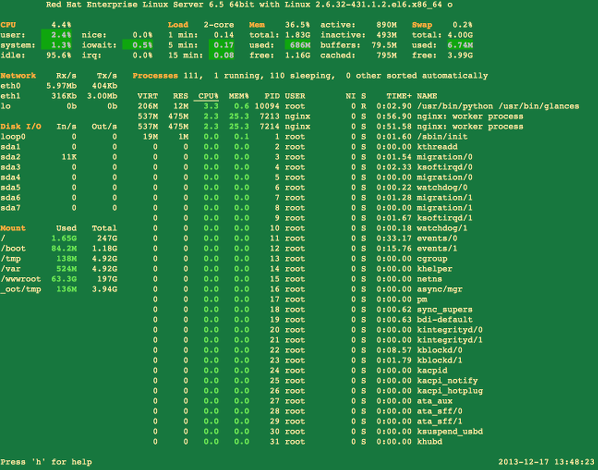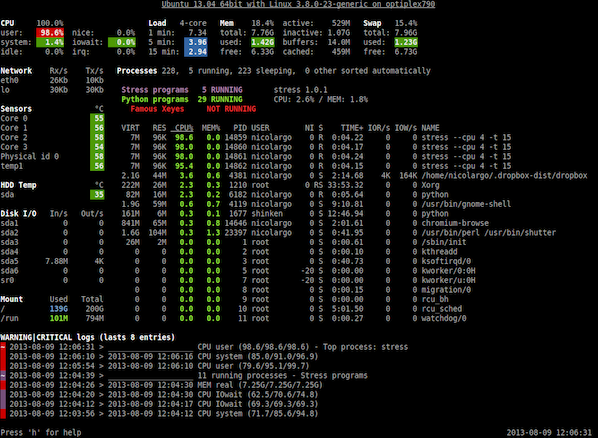Glances is a free (LGPL) cross-platform curses-based monitoring tool which aims to present a maximum of information in a minimum of space, ideally to fit in a classical 80x24 terminal or higher to have additionnal information. Glances can adapt dynamically the displayed information depending on the terminal size. It can also work in a client/server mode for remote monitoring.
This tool provide info about your server
1.CPU load
2.OS Name/Kernel version
3.System load
4.Disk and Network I/O
5.Process
6.Memory usage
7.Mount point and much more.
To quit just press q (Esc and Ctrl-C also work). Here is another output from Ubuntu based system:
This tool provide info about your server
1.CPU load
2.OS Name/Kernel version
3.System load
4.Disk and Network I/O
5.Process
6.Memory usage
7.Mount point and much more.
Installation
You can install Glances using pip command line tool. You will also find packages for Arch Linux, Fedora/CentOS/RHEL, Debian, Ubuntu (13.04+), FreeBSD, OSX and so you should be able to install it using your favorite package manager as follows:
Install Glances on CentOS/Fedora/RHEL/Scientific Linux
First, turn on Extra Packages for Enterprise Linux (or EPEL) repo on CentOS/RHEL/SL. Type the following yum command:
Sample outputs:
# yum -y install glancesSample outputs:
yum install glances Loaded plugins: product-id, protectbase, rhnplugin This system is receiving updates from RHN Classic or RHN Satellite. rhel-x86_64-server-6 | 1.5 kB 00:00 rhel-x86_64-server-optional-6 | 1.5 kB 00:00 0 packages excluded due to repository protections Setting up Install Process Resolving Dependencies --> Running transaction check ---> Package glances.noarch 0:1.7.1-1.el6 will be installed --> Processing Dependency: python-psutil >= 0.4.1 for package: glances-1.7.1-1.el6.noarch --> Processing Dependency: python-setuptools for package: glances-1.7.1-1.el6.noarch --> Running transaction check ---> Package python-psutil.x86_64 0:0.6.1-1.el6 will be installed ---> Package python-setuptools.noarch 0:0.6.10-3.el6 will be installed --> Finished Dependency Resolution Dependencies Resolved ============================================================================ Package Arch Version Repository Size ============================================================================ Installing: glances noarch 1.7.1-1.el6 epel 107 k Installing for dependencies: python-psutil x86_64 0.6.1-1.el6 epel 84 k python-setuptools noarch 0.6.10-3.el6 rhel-x86_64-server-6 336 k Transaction Summary ============================================================================ Install 3 Package(s) Total download size: 527 k Installed size: 843 k Is this ok [y/N]: y Downloading Packages: (1/3): glances-1.7.1-1.el6.noarch.rpm | 107 kB 00:00 (2/3): python-psutil-0.6.1-1.el6.x86_64.rpm | 84 kB 00:00 (3/3): python-setuptools-0.6.10-3.el6.noarch.rpm | 336 kB 00:00 ---------------------------------------------------------------------------- Total 1.8 MB/s | 527 kB 00:00 Running rpm_check_debug Running Transaction Test Transaction Test Succeeded Running Transaction Installing : python-psutil-0.6.1-1.el6.x86_64 1/3 Installing : python-setuptools-0.6.10-3.el6.noarch 2/3 Installing : glances-1.7.1-1.el6.noarch 3/3 Verifying : python-setuptools-0.6.10-3.el6.noarch 1/3 Verifying : python-psutil-0.6.1-1.el6.x86_64 2/3 Verifying : glances-1.7.1-1.el6.noarch 3/3 Installed: glances.noarch 0:1.7.1-1.el6 Dependency Installed: python-psutil.x86_64 0:0.6.1-1.el6 python-setuptools.noarch 0:0.6.10-3.el6 Complete!
Install Glances on Debian/Ubuntu Linux (13.04+)
Type the following command:
$ sudo apt-get install glancesHow do I use glances?
The basic syntax is:
Sample outputs:
# glances
# glances [options]Sample outputs:
To quit just press q (Esc and Ctrl-C also work). Here is another output from Ubuntu based system:
HTML5 capable browser user can view quick video demo by clicking the following link:
Fine tuning output (interactive commands)
Use the following hot keys to find tune your output:
- a Sort processes automatically.
- c Sort processes by CPU%.
- m Sort processes by MEM%.
- p Sort processes by name.
- i Sort processes by I/O rate.
- d Show/hide disk I/O stats.
- f Show/hide file system stats.
- n Show/hide network stats.
- s Show/hide sensors stats.
- y Show/hide hddtemp stats.
- l Show/hide logs.
- b Bytes or bits for network I/O.
- w Delete warning logs.
- x Delete warning and critical logs.
- 1 Global CPU or per-CPU stats.
- t View network I/O as combination.
- u - View cumulative network I/O.
How do I use Glances in client/server mode?
On server type the following command to bind server to the given IPv4/IPv6 address or hostname:
From your desktop client such as OSX/FreeBSD/Linux based system type the following command to connect to a Glances server by IPv4/IPv6 address or hostname:
You may need to pass the -P password to set a client/server password. The -s run Glances in server mode:
# glances -B @IP|host
# glances -B 75.126.153.206
# glances -B www.cyberciti.bizFrom your desktop client such as OSX/FreeBSD/Linux based system type the following command to connect to a Glances server by IPv4/IPv6 address or hostname:
# glances -c @IP|host
# glances -c 75.126.153.206
# glances -c www.cyberciti.bizYou may need to pass the -P password to set a client/server password. The -s run Glances in server mode:
How do I refresh information every 5 seconds?
Type the following command:
# glances -t 5
More info check source : http://www.cyberciti.biz , https://github.com/nicolargo/glances



No comments:
Post a Comment